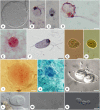Are Human Intestinal Eukaryotes Beneficial or Commensals?
- PMID: 26270819
- PMCID: PMC4536199
- DOI: 10.1371/journal.ppat.1005039
Are Human Intestinal Eukaryotes Beneficial or Commensals?
Conflict of interest statement
The authors have declared that no competing interests exist.
Figures

References
-
- Bogitsh BJ, Carter CE, Oeltmann TN (2012). Human Parasitology, 4the edition Elsevier Academic Press, San Diego, USA; 430 pp.
-
- Lewthwaite P, Gill GV, Hart CA, Beeching NJ (2005). Gastrointestinal parasites in the immunocopromised persons. Curr Opin Infect Dis 18: 427–35. - PubMed
Publication types
MeSH terms
LinkOut - more resources
Full Text Sources
Other Literature Sources

